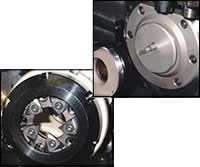Putting More Teeth In Thread Whirling
When it comes to producing OD threads in difficult-to-machine metals, few processes are as fast or as efficient as the thread whirling process. Although the process is not new, its popularity is increasing because of the growing availability of thread whirling tooling for single-spindle Swiss screw machines that provides a relatively inexpensive alternative to investing in dedicated thread whirling machines.
When it comes to producing OD threads in difficult-to-machine metals, few processes are as fast or as efficient as the thread whirling process. Although the process is not new, its popularity is increasing because of the growing availability of thread whirling tooling for single-spindle Swiss screw machines that provides a relatively inexpensive alternative to investing in dedicated thread whirling machines.
In the thread whirling process, the blank to be threaded extends from the machine spindle, rotating at low rpm. A ring-shaped toolholder contains several identical, evenly spaced, formed inserts whose cutting edges face the opening in the ring (see photo). It rotates on a slightly off-center axis about the blank, rotating in the same direction as the blank but at a much higher rpm. As the toolholder “whirls” about the blank, each of the inserts in turn takes a bite of it. Unlike single-point threading, in which one cutting edge takes the entire cutting load over several passes, the thread whirling process distributes the cutting load over several teeth—and the thread is cut to full depth in a single pass, making for much shorter cycle times.
One of newest thread whirling tools on the market is an addition to the Schwanog WEP indexable insert system available from GST Tooling Corp. (Roselle, Illinois). The toolholder features five triangular inserts instead of the three circular cutters used on a competitive thread-whirling toolholder, which should make for lighter chip loads and longer tool life. When tool wear occurs, each insert can be removed with one screw, indexed to a fresh edge and secured. Worn inserts can be resharpened by grinding. GST supplies the inserts to the customer ground to the desired thread form.
The sequence of illustrations below shows the thread whirling process. In the first frame, the tool is set to the appropriate helix angle and positioned in front of the spindle. The second frame shows the threading in process. The thread is created by the C-axis rotation of the blank and its longitudinal movement in the Z axis. As the side view shows, only one of the inserts engages the blank at any given time. In the final frame, after the desired thread length has been formed in a single pass, tool and threaded blank separate radially and axially.
As shown in the photo to the right, the thread whirling toolholder installs in an attachment that mounts on one of the Swiss screw machine’s rotary tool stations. The thread whirling tool can be used on all Star, Meier and other single-spindle Swiss screw machines. The attachment can be moved among several machines in the shop as job scheduling requires.
Schwanog developed the thread whirling system in part to meet the growing demand for medical and dental implants. The components for such implants are made primarily from stainless steel or titanium to ensure a high level of biocompatibility. Thread whirling on a single-spindle Swiss screw machine provides the muscle needed to thread these difficult-to-machine metals to the precision required.
The system also offers significant cost savings compared with competitive processes such as thread milling. Indexable inserts permit fast substitutions when replacing worn edges or setting up for the next job. Schwanog claims there is a significant increase in tool service life compared with milling cutters. The company says there is also a significant savings in finishing costs because no thread finishing is required for the thread whirling process.
Related Content
Broaching Tool Technology For Lathes Used to Slot Inconel Parts
This shop finds value in using an indexable-insert-style broaching tool to create blind-hole slots in heat-treated Inconel aerospace parts on a CNC lathe.
Read MoreMicromachining Fundamentals
A number of elements must come together to establish an effective process for machining at a micro level. Here we consider four.
Read MoreThe Ins and Outs of Inserts
Understanding how inserts are made provides valuable insight into how their performance can be optimized.
Read MoreNew Cutting Tool Technology Discovered at Paul Horn Open House
During a tour of the company’s campus in Tubingen, Germany, I and more than 3,000+ others were introduced to a number of new advances the company has made in cutting tool technology particularly as it relates to the medical industry.
Read MoreRead Next
A Tooling Workshop Worth a Visit
Marubeni Citizen-Cincom’s tooling and accessory workshop offers a chance to learn more about ancillary devices that can boost machining efficiency and capability.
Read MoreDo You Have Single Points of Failure?
Plans need to be in place before a catastrophic event occurs.
Read More5 Aspects of PMTS I Appreciate
The three-day edition of the 2025 Precision Machining Technology Show kicks off at the start of April. I’ll be there, and here are some reasons why.
Read More











.png;maxWidth=300;quality=90)












